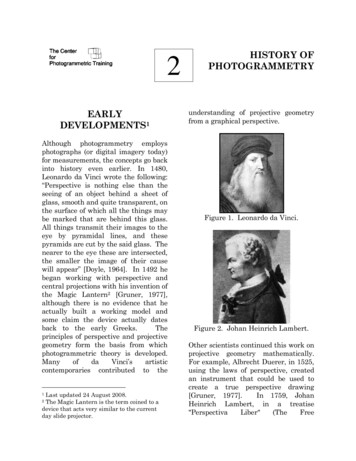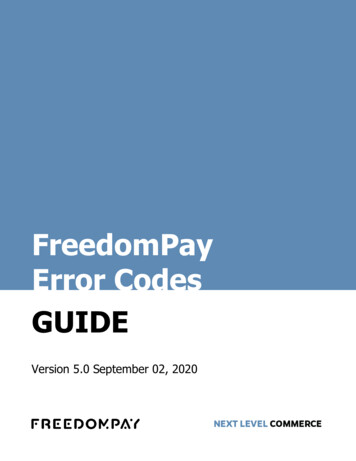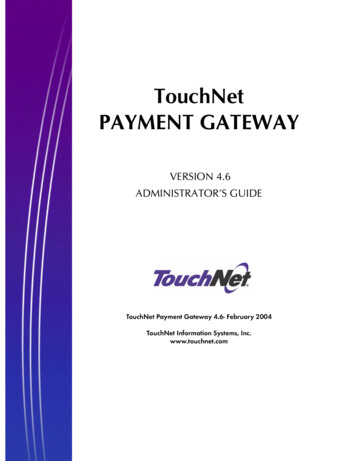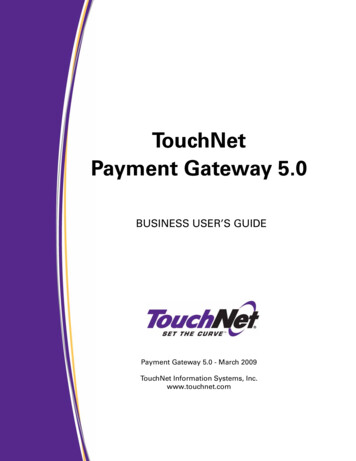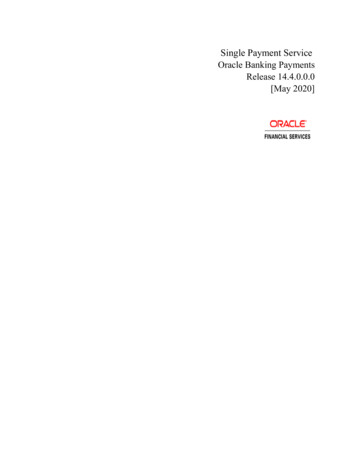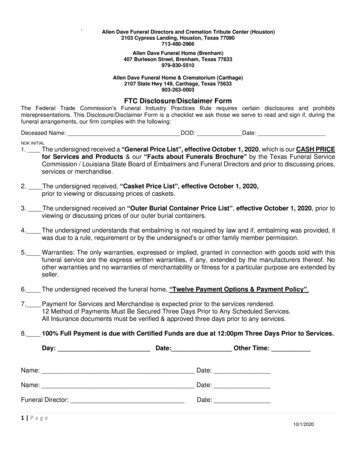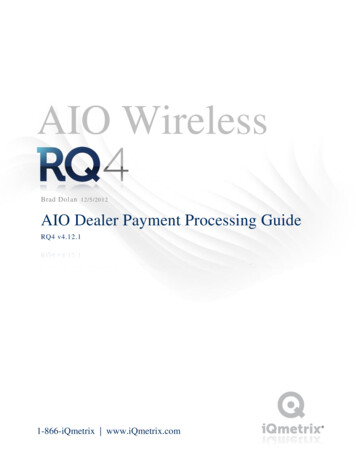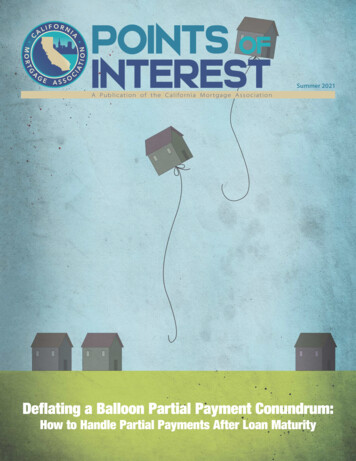
Transcription
Summer 2021A Publication of the California Mor tgage A sso ciationDeflating a Balloon Partial Payment Conundrum:How to Handle Partial Payments After Loan Maturity
Elizabeth Knight – PresidentPLM Lender Services, Inc.A P u b l i c a t i o n o f t h e C a l i f o r n i a M o r tg a g e A s s o c i a t i o nMichelle Rodriguez – Vice PresidentR.C. Temme CorporationOdell Murry – SecretaryMAI Financial Services, Inc.Richard Selzer – TreasurerSelzer Home LoansDavid Herzer – Immediate Past PresidentHerzer Financial Services, Inc.Inside This IssueFrom the President. 2From the Editor. 3Sacramento Summary. 5Steve BellevilleRedwood Mortgage Corp.James PerryAlliance PortfolioMark ForbesF.E. Forbes Company, Inc.Lori RandichBay Laurel FinancialAngelica GardnerAsher Evan InvestmentsStephen RexrodeCushman Rexrode CapitalCorporationGlenn GoldanReProp FinancialBradley Laddusaw, CPAS&L Capital GroupJoffrey LongSouthwestern MortgageSandy MacDougallMortgage Vintage, Inc.Pam SosaStandard Mortgage FinancialServices, Inc.Deflating a Balloon Partial Payment Conundrum. 7Everything You Want to KnowAbout the New Auditor’s Report.10Eleventh Circuit Decision in Hunstein PlacesShafiq TaymureeStonecrestDebt Collection Business Models at Risk. 13Richard WachterWachter Investments, Inc.Fall Seminar Save-the-Date. 15Annual and Summer Sponsors.16Michael Arnold & Michael Belote, Esq.Legislative AdvocatesT. Robert FinlayLegal CounselK. Bradley RogersonSecurities CounselCMA HEADQUARTERS STAFFJennifer Blevins, CMPDirector of Management ServicesMichael CochranWebmaster / IT ManagerTeresa Excinia, MBA, CAEExecutive DirectorStephanie SchoenSpecial ProjectsJohn BerkowitzPublications DirectorTricia Schrum, CPAAccountingJen Gross, CMPMeeting PlannerNatalie SinclairSpecial ProjectsSummer 2021PAC Contributors.18MEMBER SPOTLIGHT: Odell Murry. 21Stricktly Strickland.26is published by the CaliforniaMortgage Association, a voluntary trade associationserving California mortgage and trust deed brokersand lenders.2520 Venture Oaks Way, Suite 150Sacramento, CA 95833(916) 239-4080 – phone (916) 924-7323 – .comPage 1
Elizabeth M. Knight2021-2022 CMA Presidenthope as of this writing you are alldoing well; taking time to be with yourfamilies, taking time to take care ofyourself, staying healthy and enhancingand protecting your businesses from theongoing changes to the market and theenactment of new legislation.members perform many or all of thesefunctions themselves. Could any of youimagine simply performing one functionall day, every day? For the entrepreneurialCMA members, it would be a “roller coasteron a flat track.”exceeded the list price by 12%, all cash, and,the original list price was at market. Thereare four driving forces that create such anoccurrence: Low inventory, low interestrates, people who feel they need to jumpinto the market, people with cash.But, as any of us know who have been inthis business many years, this is a cyclicalmarket and every time there is a downwardadjustment in the market it follows anaccelerated uptick. My message heretoday is to be especially cautious whenwriting your loans in this type of market. Becareful of the roller coaster rush of beingable to write a loan today because of thelower LTV that you wouldn’t have writtensix months ago.— Suspense writerDean KoonzSometimes, although we ride a rollercoaster ride every day, we want to make itwilder than it already is. Perhaps, it is nota conscious choice. It is just somethingthat wants us to feel bolder, more creative,just . more. But, when looking back wethink, “What was I thinking? Why did I workwith that borrower? Why did I let thempush me into closing so quickly withoutperforming as much due diligence as Inormally do? Why did I step outside myknowledge base without further review orconsult on this loan?” Maybe it is becausewe want a bit of the shrieking highs andlows of any great roller coaster to rise tothe precipice, free fall and then soar again.Many of the CMA members consist of smallenterprises which allow (or make) theowners to perform and perfect so manydifferent functions of their business. Wherea large company has a team of loan officers,processors, underwriters, loan committeesfor different types of loans, funders, closers,post-close auditors, HR teams, accountingdepartments, marketing departments anda myriad of other departments, our CMACurrently, the real estate market is, in manyareas, rising in value very quickly. Propertiesthat sold last month for 1,250,000 are nowselling for 1,450,000. We are seeing notjust multiple offers but unprecedentednumbers of multiple offers causing offersto exceed list price by as much as 10%,maybe more in some areas. I was talkingto one agent who had 85 offers come in onone property and the final accepted offerAs I had mentioned in the last Points ofInterest President’s Message, I enjoy sharingquotes from famous people. This edition’squote best described my thoughts aboutCMA as a group since we are strong andbold:Yeah, life is complicated, butif it wasn’t complicated, itwould be a roller coaster on aflat track. Wouldn’t be a rideworth taking.Page 2Really get a feel of the values in your area,where they were and where they are goingand how quickly. Perhaps you always werewriting at 70% LTV. Today, you may wantto be more conservative. Although themarket seems like it won’t be adjustinganytime soon since the rates are stayinglow for at least a year or more, so say thefeds, and the building of homes hasn’tcaught up with demand, the buildingwill catch up and unless you are writingvery short term loans, your loan couldget caught up in that. In some areas, tenscontinued on page 27Summer 2021
Mayumi BowersEditor,hope that the first half of 2021 was fruitfulfor your business. I know that I wasincredibly busy this year and my busynessdidn’t just come from new loans coming. Alot of it came from making improvementsto our current processes and procedures,implementing the new rules and regulationsthat have come as a result of COVID-19, andThe articles in this edition, touch on a coupleof things that aren’t necessarily new but arealways good to revisit. It is a nice reminderof those things that you should be doing, butthat may have slipped to the back burner. Ihope that the second half of 2021 will be greatfor everyone, and I look forward to seeingeveryone at the Fall Seminar in Las Vegas. Asanother reminder, we are always looking fornew articles and newsletter ideas.Steve BellevilleGlenn GoldanBradley Laddusaw, CPAOdell MurryStephen RexrodePam SosaSummer 2021shoring up the things that we should havebeen doing but had not had the time to do.These things alone have made us incrediblybusy on top of dealing with new loanscoming in.Page 3
Page 4Summer 2021
By Michael J. Arnold & Michael D. Belote, Esq.CMA Legislative AdvocatesThe Legislature is scheduled to adjournthis first year of the 2021-2022 twoyear legislative session on September10th. Thus, it is a sprint to the end of thesession. In many respects, this is the mostdangerous period of the Legislature. Billsare often “highjacked” at this time of yearand a bill on garbage trucks can suddenlybecome a bill on mortgage lending. Itis for that reason that your lobbyistsin Sacramento read every amendmentto every bill daily. Amendments cantransform a bill in our “watch” categoryinto a measure we must strongly oppose– and on short notice.COVID-19 has made this session of theLegislature the strangest one ever!Members and staff have been difficultto reach, and lobbying committees hasrequired considerably more effort. Thusfar, we have been successful in our effortsto stop bad legislation or, in some cases,avoid the introduction of bad ideas in theform of legislation we would have opposed.The Legislature and the Governor have hadmany issues to deal with this year includingCOVID-19, housing, homelessness, and abudget outlook which went from a 54Billion deficit to almost a 100 Billionsurplus. The roaring economy andsignificant assistance from Washingtoncreated a situation where the biggestproblem for the Democratic majority inthe Legislature was how to spend theunanticipated revenue.As we have reported, early in the sessionthe Governor signed a bill extendingthe State’s eviction moratorium throughSeptember and boosting funding for arent relief program addressing the needs ofSummer 2021both tenants and landlords. Working withother groups in the lending industry, wewere able to avoid legislation which wouldhave impacted the foreclosure process.Several bills which did not pass this year,however, are now “two-year bills” whichwill be eligible for further considerationduring the second year of this two-yearsession.CMA is closely tracking over 60 bills duringthis session. Some of the measures on ourlist include the following:AB 345:Would allow an ADU to be conveyedseparate from the primary residencepursuant to a local ordinance – in Senateand likely to pass.AB 255:Would enact the C0VID Emergency SmallBusiness Eviction Relief Act – killed onthe Assembly Floor. This measure wouldhave created more problems than itwould have solved – 2-year bill.AB 561:Requires State Treasurer’s Office tohelp homeowners qualify for loans toconstruct ADUs and junior ADUs – inSenate and likely to pass.AB 948:Enacts measures to prevent unlawfuldiscrimination in the conduct of realestate appraisals: (1) provides noticeto buyers and sellers of their right toan unbiased appraisal of the property;(2) establishes a mechanism to trackcomplaints of underappraisals bydemographics; (3) requires appraisersto complete continuing educationeliminating bias and cultural competency– in Senate and likely to pass.AB 1405:Creates the Fair Debt SettlementPractices Act regulating debt settlementof unsecured debt, such as credit carddebt – in Senate and likely to pass.AB 1466:Establishes task force to search, redact,and compile a publicly searchabledatabase of unlawful and discriminatoryrestrictive housing covenants – in Senateand likely to pass.SB 263:Requires 2 hours training on “implicitbias” as part of the 45-hour continuingeducation for realtor license renewal – inAssembly and likely to pass.SB 373:Defines “economic abuse” as certaintypes of debt – 2-year bill.SB 449:Requires specified lenders to report onclimate-related risks in their portfolios tothe Department of Financial Protectionand Innovation – 2-year bill.SB 531:Amends the Rosenthal Fair DebtCollection Practices Act and the FairDebt Buying Practices Act. Defines theterm “delinquent debt” as “a consumerdebt, other than a mortgage debt, thatis past due at least 90 days and has notbeen charged off” – in Assembly andlikely to pass.Page 5
Page 6Summer 2021
Sarah E.GreenbergDavis, Esq.Wright, Finlay& Zak, LLPT. RobertFinlay, Esq.Wright, Finlay& Zak, LLPDeflating a Balloon PartialPayment Conundrum:How to Handle PartialPayments After Loan Maturityf you service loans with balloon payments,you have almost assuredly faced a situationwhere the loan has matured, but the borrowerfails to remit the full payment amount owed.Instead, you receive a partial payment andare left with two options – reject or acceptthe payment.Many times, the servicer, generally at thedirection of the lender, accepts the partialpayment. But, by accepting, have you alsoinadvertently agreed to extend the loanterms? Moreover, if you accept do youalso need to send a new notice of paymentpursuant to Civil Code section 2924i? Theanswer is found in the interplay betweenCalifornia Civil Code section 2924i and anynon-waiver clause contained in the loandocuments.A. How Does Civil Code Section2924i Apply to Balloon Loans?A balloon loan is a loan that does notfully amortized over the course of theloan term. That means any paymentsSummer 2021made by the borrower will not pay theloan off in full, which results in a large finalpayment at maturity. With respect toresidential loans, the Legislature decidedthat borrowers needed to be reminded ofthe final payment to ensure awareness ofwhat was coming due and adequate timeto prepare. Thus, Civil Code section2924i, which requires the servicer send anotice of final balloon payment to theborrower, was enacted. In short, thestatute applies to balloon loans which arefor a period of longer than one year,secured by a deed of trust on realproperty containing one to fourresidential units, of which at least one isoccupied by the borrower. Civil Codecontinued on page 8Page 7
Balloon Payments – continued from page 7section 2924i(a). The statute requires thelender provide a notice of final paymentto the borrower at least 90 days, but nomore than 150, before the final paymentis due. Civil Code section 2924i(c). Thisnotice must identify the date the finalballoon payment is due, the paymentamount, where the payment should besent, and whether the borrower has acontractual right to refinance. Civil Codesection 2924i(c). Failure to send the noticetimely does not invalidate the loan but willextend the loan terms via operation of lawto a date at least 90 days after the noticedate, thus delaying collection on the loan.Civil Code section 2924i(e), (f). Moreover, awillful violation of the statute can result inan award of actual damages and attorney’sfees. Civil Code section 2924i(f).As relevant to our question above, thissection also states that “[i]f the due dateof the final payment of a loan subjectto this section is extended prior to thetime notice is otherwise required underthis subdivision, this notice requirementshall apply only to the due date asextended (or as subsequently extended).”Civil Code section 2924i(c). Thus, ifaccepting a payment after the loan maturesautomatically extends the loan terms, thenyou would arguably also need to sendanother notice to comply with Civil Codesection 2924i(c) in situations where the loanis extended more than 90 days.B. Can Acceptance AloneExtend the Loan Terms?As a general matter the parties’ courseof conduct, i.e., acceptance of partialpayments post-maturity, can extend theloan terms, usually through applicationof equitable principles such as waiver orestoppel.Waiver is the intentional relinquishment ofa known right after knowledge of the facts.Waller v. Truck Ins. Exchange, Inc. (1995) 11Cal.4th 1, 31. To succeed on his waiver claim,the borrower would need to prove by clearand convincing evidence that the lenderfreely and knowingly gave up its right torequire the borrower to pay the full amountPage 8owed on the maturity date. Id. Notably, awaiver can be oral, written or it can arisefrom conduct that shows the lender clearlygave up the right. Id., see also Howard J.White, Inc. v. Varian Associates (1960) 178Cal.App.2d 348, 353-355.Estoppel is an equitable doctrine codifiedin California Evidence Code section 623,which provides that when a party, by eitherstatement or conduct, leads another tobelieve a particular thing is true and thesecond party acts in reliancethereon, thefirst party is not permitted to contradictthat statement or conduct in any litigationarising out of that statement or conduct.Cal. Evid. Code section 623. To succeedon an estoppel claim, the borrower wouldneed to show that the lender knew aboutthe breach of the loan payment terms butextended the loan term by accepting thepartial payment, that the lender intendedits conduct to be acted upon, that theborrower did not know differently thatthe loan had not been extended, and thatthe borrower relied upon the statement orconduct to his detriment. DRG/Beverly Hills,Ltd. v. Chopstix Dim Sum Café & Takeout III,Ltd. (1994) 30 Cal.App.4th 54, 59.C. How Do I Protect Myself?While the lender’s course of conduct/acceptance of payment can potentiallyextend the loan terms, generally allloans also contain an anti-waiver clausespecifically to prohibit such an occurrence.(Note – if you loan documents do notcontain one, they should!) Anti-waiverclauses generally provide that a lenders’failure to enforce its contractual rights ina breach situation shall not constitutea waiver of that breach or the remediesavailable to the lender. Many alsospecifically provide that acceptance of latepayments or partial payments does notconstitute a modification of the loan or awaiver of any other remedy available bylaw. These clauses are consistently upheldby courts across the nation based on theirplain language, but enforcement is basedon the parties’ actual conduct, which mustbe consistent with the anti-waiver clauseterms.Here, assuming the lender’s loan documentscontain an anti-waiver clause which coversacceptance of payments post- maturity,the lender’s mere acceptance of thepartial payment would not extend theloan terms. This is, of course, subject tothe above caveat that the lender’s otherconduct is consistent. For instance, if theservicer orally representsto the borrowerthat the loan due date has been extendedor a monthly statement is sent to theborrower showing a different due datepost acceptance of the partial payment, acourt could find that the lender waived theanti-waiver clause protections based onthat separate conduct. As a best practice,in situations where the lender decides toacceptthe partial payment, we recommendthe servicer also send a reservation of rightsletter to the borrower specifically advisingthem that acceptance of the payment isnot to be considered a modification of theloan or a waiver of any of the loan terms.This letter would not only cut against anyargument by the borrower that the lenderintended to modify the loan, but also bestrong evidence that the borrower knewthe acceptance was not a modification ofthe due date.We are aware that some servicers willsometimes send a new 90-day noticeunder Section 2924i if they accept a partialpayment. However, we do not recommendsuch a course of action for two reasons.First, logic dictates that since the loanterms have not been extended, a new90-day notice is not necessary to complywith the statute’s requirements. Second,sending such a notice could actually beproblematic because it could be used bythe borrower as evidence that the lenderintended to voluntarily extend the duedate, otherwise why did the lender sendthe new notice in the first place.In summar y, f irst check your loandocuments and review the anti-waiverprovision. If it does not already specificallyaddress acceptance of late/partialpayments, consider revising it. Next,consider implementing a policy requiringcontinued on page 9Summer 2021
Balloon Payments – continued from page 8a reservation of rights letter be sent tothe borrower in situations where a partialpayment is going to be accepted postmaturity. Ultimately, if you are unsurewhat level of protection you currentlypossess, please reach out to Wright, Finlay& Zak, LLP or your counsel to discuss yourspecific situation.If you have any questions regardingthis topic, please do not hesitate tocontact Sarah Greenberg Davis at sdavis@wrightlegal.net or Robert Finlay at rfinlay@wrightlegal.net.Disclaimer: The above information isintended for information purposesalone and is not intended as legal advice.Please consult with counsel beforetaking any steps in reliance on any of theinformation contained herein.Sarah Greenberg Davis is a Senior AssociateAttorney at WFZ’s California office. RobertFinlay is a founding Partner of WFZ.Summer 2021Page 9
Everything YouWant to KnowAbout the NewAuditor’s ReportHenry ChavezSpiegel Accountancy Corp.After seemingly eons of time thatwe have had to become familiarwith the standard auditor’s report,it is about to categorically change. That’sright, the Auditing Standards Board (ASB)of the American Institute of Certified PublicAccountants (AICPA) has changed theauditor’s report by issuing Statement ofAuditing Standard (SAS) No. 134, AuditorReporting and Amendments, includingAmendments Addressing Disclosures in theAudit of Financial Statements.This new auditor’s report, which becomeseffective for all reporting periods endingon or after December 15, 2021, is designedto give us a whole new literary thrill inaudit reporting because the report ispresumably more relevant and transparent.Be forewarned as I attempt to elaborateon the new standard with an injection ofhumor. After all, who wants to read a dryarticle on auditor’s reports?Why the Change?The ASB issued the new auditor’s report tocoincide with international auditing andassurance standards and create consistencywith the auditor’s report previously issuedby the Public Company AccountingOversight Board.Page 10The new auditor’s report is intended toincrease its value by providing moretransparency into the audit and supplyingthe user with more information on theauditor’s and management’s responsibilityfor the audit.What Are the Changes?In our opinion, the accompanyingfinancial statements present fairly, in allmaterial respects, the financial positionof Company X as of December 31, 2021,and the results of its operations and itscash flows for the year then ended inaccordance with accounting principlesgenerally accepted in the United Statesof America.1. FaceliftThe first thing you will notice is the entirestructure of the auditor’s report was flipped.In short, the audit opinion now comes firstrather than last. Yes sir, no more waitingfor the auditor’s punch line to come at theend of the joke, as it will now come first.Report on the Audit of theFinancial Statements (Template)2. We are independent,ethical, and we own itThe “Basis for the Opinion” is a new sectionin the auditor’s report that provides clarityregarding the auditor’s obligations. Here issomething new in the paragraph: we areethical and independent. We as auditorsfind this amusing, and you should too sincethis is the reason you hired us.OpinionBasis for Opinion (Template)We have audited the financial statementsof Company X, which comprises thebalance sheet as of December 31, 2021,and the related statements of income,changes in stockholders’ equity, andcash flows for the year then ended,and the related notes to the financialstatements.We conducted our audit in accordancewith auditing standards generallyaccepted in the United States of America(GAAS). Our responsibilities under thosestandards are further described in theAuditor’s Responsibilities for the Auditof the Financial Statements sectioncontinued on page 11Summer 2021
Auditor’s Report – continued from page 10of our report. We are required to beindependent of Company X and to meetour other ethical responsibilities, inaccordance with the relevant ethicalrequirements relating to our audit. Webelieve that the audit evidence we haveobtained is sufficient and appropriateto provide a basis for our audit opinion.3. Management, you are stillresponsible, tooManagement, you are lucky! Not much haschanged in what we have to say about yourrole in making sure the financial statementsare correct. Essentially, you must promiseus your company will not fold within 12months of issuing the financial statements.Remember, management is responsible forthe financial statements, not the auditor.Responsibilities of Management forthe Financial Statements (Template)Management is responsible for thepreparation and fair presentation ofSummer 2021the financial statements in accordancewith accounting principles generallyaccepted in the United States of America,and for the design, implementation, andmaintenance of internal control relevantto the preparation and fair presentationof financial statements that are free frommaterial misstatement, whether due tofraud or error.In preparing the financial statements,management is required to evaluatewhether there are conditions or events,considered in the aggregate, that raisesubstantial doubt about Company X’sability to continue as a going concern forone year after the date that the financialstatements are issued.4. A discourse on your auditor andwhat work we do in your auditAnyone who reads the new auditor’sreport will now have the joy of obtainingan auditor’s “101 guide” through the auditprocess. Voilà! Here is everything youwanted to know about the steps auditorsperform.Auditor’s Responsibilities for the Auditof the Financial Statements (Template)Our objectives are to obtain reasonableassurance about whether the financialstatements as a whole are free frommaterial misstatement, whether dueto fraud or error, and to issue anauditor’s report that includes ouropinion. Reasonable assurance isa high level of assurance but is notabsolute assurance and therefore is nota guarantee that an audit conductedin accordance with GAAS will alwaysdetect a material misstatement whenit exists. The risk of not detectinga material misstatement resultingfrom fraud is higher than for oneresulting from error, as fraud may involvecollusion, forgery, intentional omissions,misrepresentations, or the overridecontinued on page 12Page 11
Auditor’s Report – continued from page 11of internal control. Misstatementsare considered material if there is asubstantial likelihood that, individuallyor in the aggregate, they would influencethe judgment made by a reasonableuser based on the financial statements.In performing an audit in accordancewith Generally Accepted AuditingStandards, we: Exercise professional judgment andmaintain professional skepticismthroughout the audit. Identif yand assess the risks of materialmisstatement of the financialstatements, whether due to fraud orerror, and design and perform auditprocedures responsive to those risks.Such procedures include examining,on a test basis, evidence regardingthe amounts and disclosures in thefinancial statements. Obtain an understanding of internalcontrol relevant to the audit in orderto design audit procedures that areappropriate in the circumstances,but not for the purpose of expressingan opinion on the effectivenessof Company X’s internal control.Accordingly, no such opinion isexpressed. Evaluate the appropriatenessof accounting policies used andthe reasonableness of significantaccounting estimates made bymanagement, as well as evaluate theoverall presentation of the financialstatements. Conclude whether, in our judgment,there are conditions or events,considered in the aggregate, that raisesubstantial doubt about Company X’sability to continue as a going concernfor a reasonable period of time.We are required to communicatewith those charged with governanceregarding, among other matters, theplanned scope and timing of the audit,significant audit findings, and certainPage 12internal control–related matters thatwe identified during the audit.5. The new and excitingKey Audit Matters (KAM)The intent of this new, optional paragraphin the auditor’s report is to disclose themost important audit matters encounteredduring the audit. The spirit of this newparagraph is to provide better informationto users of the financial statements and toimprove governance. While the AICPA maybe excited about this revision, it remainsto be seen how beneficial it may be to thereader of the financial statements. Further,key audit matters are already discussed inthe communication with those chargedwith governance letter that auditors arerequired to provide to management.Key Audit Matters (Example)Key audit matters are those matters thatwere communicated with those chargedwith governance and, in our professionaljudgement, were of most significance inour audit of the financial statements of thecurrent period. These matters were addressedin the context of our audit of the financialstatements, and in forming our opinionthereon, and we do not provide a separateopinion on these matters.In truth, the changes to the auditor’sreport should not impact the viewpointof any reader. Therefore, you should nothave to prepare them for it, other thanletting them changes exist. Should you elect to include KAMs in theauditor’s report?Given that the paragraph is optional,prior to including it, management shouldreally consider whether it adds value tothe readers of your financial statements.If you have any questions about SAS 134,please contact me. I’m happy to help.Henry Chavez serves as a strategic resourcefor growing organizations, guiding theirdevelopment and success. A seasoned publicaccountant, Henry provides assurance andbusiness consulting services to privatelyheld businesses in the financial services,manufacturing and distribution, technology,and non-profit sectors.The most sensitive accounting estimateaffecting the financial statements is CompanyX’s estimate of the collectability and valuationof mortgage loans receivable, which is basedon historically collections and the fair valueof collateral. We evaluated and tested the keyfactors and assumptions used to determinefair value and found them to be reasonablein relation to the financial statements takenas a whole.Are You Ready For the Change?The two issues management shouldconsider prior to the adoption of SAS 134are as follows: Do I need to inform the readers of thefinancial statements about the changein financial statement reporting?Summer 2021
Eleventh Circuit Decision in HunsteinPlaces Debt Collection Business Models at RiskBrett L.Foster, Esq.Wright, Finlay& Zak, LLPMichelle A.Mierzwa, Esq.Wright, Finlay& Zak, LLPn April 21, 2021, the U.S. Court of debt, (3) the entity to which he owedAppeals for the Eleventh Circuit the debt, (4) that the debt concerned hisissued an opinion in Hunstein vs. son’s medical treatment, and (5) his son’sPreferred Collection and Management name. Compu
For the entrepreneurial CMA members, it would be a “roller coaster on a flat track.” Sometimes, although we ride a roller . coaster ride every day, we want to make it . wilder than it already is. Pe

